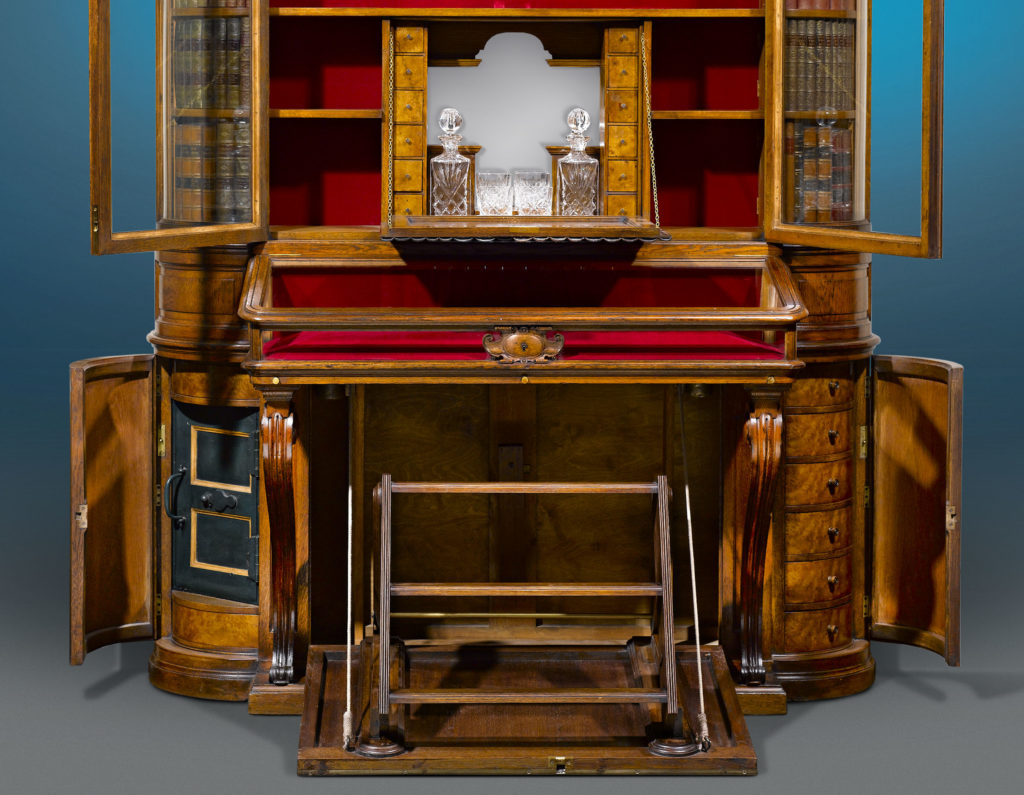Above: A rare 19th century Italian desk, also known as King Carlo Alberto's desk, with several secret compartments. Learn more about antique desk styles.
These days most people opt to store their cash and most prized valuables in banks or safety deposit boxes, but before the turn of the 19th century, neither of these services existed. Having furniture with hidden compartments was one method of protecting one's most valuable possessions against thieves - secret safes, false bottom drawers, hidden cabinets, and cleverly placed hidden door panels were all used to baffle outsiders.
Secret compartments in furniture design have been the subject of literary plot twists for centuries. There is something timeless in the drama of finding hidden treasures such as large sums of money, heirloom jewels, silver, a missing will, or a written confession of a crime committed many years ago. And rightly so — the possibility of discovering a long-forgotten treasure or solving a mystery is almost universally alluring.
In the mystery, The Purloined Letter by Edgar Allen Poe, the French Chief of Police searches the apartments of a royal minister for a letter stolen from royalty, but in vain. Frustrated, he states, “Any man is a dolt who permits a 'secret' to escape him in a search of this kind. The thing is so plain. There is a certain amount of bulk of space to be accounted for in every cabinet.”
The Chief obviously knew little about these ingenious demonstrations of the cabinetmaker's skill. A seemingly average piece of antique furniture could be sitting in its owner's home for years, only for secret compartments to be found when it is sent to a restorer or cabinetmaker for reconditioning. Secret compartment storage in furniture plans could be incredibly complicated and require a highly skilled craftsman to execute. A secrétaire could be hiding one secret; a sideboard could be hiding a score!
Our gallery houses several high-quality pieces of antique furniture that offer a lovely statement to a room at first glance - but some of them also feature exceptionally clever secret hiding spots and hidden storage space. Read on to learn more about these fascinating pieces.
18th-Century English Secrétaire

This secretaire, from the front, appears to be a high-end, but typical piece that would have been owned by a wealthy family. No one would guess it was really secret compartment furniture that had extra storage space.

|
The secretary bookcase, or secrétaire, was an innovative piece of writing furniture introduced in the early 18th century. For the wealthiest households, it proved to be the preferred type of writing furniture design. They soon became the focal point of the manor, serving as statements of culture and education. This Queen Anne-era walnut secrétaire would likely have been used often by its owners and thus served as the perfect spot for a “hidden in plain sight” plot twist.

The secrétaire already has several pigeonholes and drawers for storage, but this piece also features an impressively well-hidden false back concealed compartment that would have been entirely invisible to the eye. To reach it, one would have to remove the bottom left-hand drawer and pull on the oak fillet, which is tucked flush with the side. This is one of the most secret secret compartments we have seen in our gallery.
French Exhibition Mechanical Secrétaire by Daubet & Dumarest


This one-of-a-kind French secrétaire was crafted by Daubet & Dumarest for presentation at the Great Exhibition of 1851 in London's Crystal Palace. It is a strikingly beautiful piece on its own, with tulipwood and rosewood veneering. Upon opening, the interior is decorated with fine Boulle marquetry brass, pewter, and an extraordinarily rare green tortoiseshell.
With the turn of a single key at the very top, a slew of secret compartments and hidden storage pop open in some of the most inconspicuous of places. The top drawer slides open, and hidden space for valuables is revealed - and there is another sub-compartment sitting right behind it, serving as the perfect hiding place!

Additionally, there is a secret drawer in the base plinth and at the top of the piece, neither of which could possibly be seen without the dramatic mechanical reveal.
Victorian-era Bookcase
When it came to Victorian furniture styles, not all hidden compartment furniture was about security—it could also provide entertainment and amusement for guests, hiding secrets that don’t want to be kept!


At first glance, this finely carved oak cabinet appears to be a well-crafted and beautiful piece for displaying a gentleman's finer volumes. However, it actually features a myriad of hidden compartments and secret storage, with built-in texts serving as disguised doors.
It hosts a series of unseen levers and buttons that open a variety of secret doors to reveal several hidden compartment areas, including a working safe, which could house important documents, cash, or heirlooms. The lower cabinet opens to a three-step staircase, allowing one to reach the top shelf easily.
Additionally, the central “texts” drop forward to reveal a bar, providing any discerning gentleman the perfect opportunity for a nightcap. If you’re looking to learn about other furniture periods, visit our blog to learn about federal style furniture or explore the characteristics of Chippendale style furniture.
Check out our extensive collection of one-of-a-kind antique furniture pieces, including more with hidden compartments and secret storage, on our online gallery. Or, visit us in person and see these monumental pieces in action for yourself! Each piece is unique, rare, or just plain fascinating.






